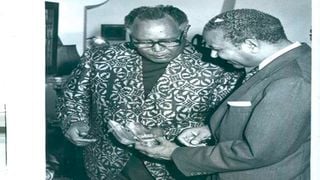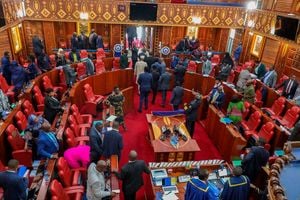
Mr Joseph Murumbi (left), a former vice-president, shows some antiques to the Unesco director general Amadou Mahtar M’Bow when he visited Murumbi’s residence in Muthaiga, Nairobi in 1976.
FILE | NATION
News
Premium
We owe Murumbi an apology or the ghosts of Intona Ranch will haunt us for years
What you need to know:
- For a man who never wronged anybody and was less controversial, Murumbi lost all that he lived for.
- His Muthaiga house that he donated for the establishment of Africa study centre was sold for a song as well as his ranch in Trans Mara, which is now owned by the Deputy President.
It was early 1990: Strapped on a wheelchair, distraught and speechless – Kenya’s second vice-president, Joseph Murumbi, watched as the bulldozers tore down what he thought would be his legacy.
The 2.14 acre piece of land in Nairobi’s Muthaiga suburb, the splendid house he once called home and the indigenous trees he had for years protected were now being knocked down, one by one. His dream of having a Murumbi Institute of African Studies, or by another name, was evaporating. He had bequeathed all that property, and for a song, to the government. Mr Murumbi was, to a fault, too trusting - and had trusted the wrong entity.
The Kanu daddies and their offspring had no value for heritage. And now, as he soon found out, the government had handed the plot, worth millions of shillings, to some three “developers”, some Moi era barons, and for a song too – Sh73,000 for each of the three subdivided plots.
Murumbi, who had travelled from his Intona Ranch in Transmara – which featured this week in Parliament as part of William Ruto’s empire – cried out, hoping to be heard. His mansion’s century-old Zanzibari door was nowhere. The land and building he had acquired in 1969 from city surgeon, Gerald Anderson, and at value, was now being wasted. Silently, he wished he never surrendered the land.
The Land and Housing minister, Darius Mbela, the man he thought would end the destruction, could only confirm that LR No 214/465 previously owned by the Kenya National Archives had been allocated to three “developers” – the tag given to the Moi-era land grabbers.
When the Nation investigated the files, it found that the government had subdivided Murumbi’s Muthaiga land into three plots of 0.7 acres. There was now LR 209/11274 allocated to Soneth Limited, whose directors were Commissioner of Lands Wilson Gachanja and his wife Elizabeth Gitiri. Soneth was an acronym of the last three letters of the directors’ first name.
The other two plots, LR 209/11275 and LR20911276 were allocated to President Moi’s son, Gideon, and to then Permanent Secretary in the Ministry of Home Affairs and National Heritage, Leonard Sawe, respectively.
This was after the Department of Physical Planning “made a proposal” for the subdivision of the land, after, according to Darius Mbela, the site was “found unsuitable for the establishment of a centre for African studies” because of the residential nature of the locality.
At first, the Prison’s Department had rehabilitated the Muthaiga house and it was said it would be the official residence of the vice-president.
Dejected, Murumbi reached out to the Kanu politicos – one last attempt. But his cries were drowned by the sounds of the bulldozers, and muted by the protected grabbers. Soon, the former vice-president returned to his Intona Ranch in Transmara, disturbed and, perhaps, agitated. He got a stroke. On June 22, 1990, five months after he tried to salvage his dream, Murumbi died and was buried at Nairobi’s city park where had always wanted to be interred close to his political mentor, Pio Gama Pinto.
Until today, I am not sure that the government has ever apologised to Mr Murumbi – nor acknowledged his contribution to our heritage. Had his dream come true, a complex financed by Unesco and named Murumbi’s Pan African International Research Centre would have been built there. It is known that owners of the two adjacent plots had agreed to sell their property to expand the centre’s acreage to 10. Unesco had agreed to fund a kitchen, a hostel and library on the premises.
Unesco had even invited an Italian firm, G. Vamos and Partners, to draw a blueprint. The Kenya National Archives, under Dr Maina Kagombe had sent its staff to catalogue the books and artefacts, which included some rare antiques which could have fetched millions in the market.

Kenya’s second vice-president, Joseph Murumbi.
At first, Murumbi had offered this collection to the East African Community but after it developed political problems, he offered the collection to the government and helped to draft the Public Archives Act. At one point, he had approached the University of Nairobi, but it had shown no interest.
But Dr Kagombe saw the potential in the Murumbi archives – and the former VP was convinced to part with them. Thus, in February 1977, with the persistence of Mr Murumbi, the government not only purchased his archives but also the house in Muthaiga which was to temporary house the collection until a proper house was purchased. But this was not a sale, per se. Murumbi had asked for a token, Sh2.5 million for the priceless collection and for his much-treasured house with the promise that it would be turned into an African study centre.
By then, Murumbi’s Africana collection was deemed the finest personal collection in the world – and perhaps the most extensive outside any national archive. When the government decided to turn the former Kenya Commercial Bank headquarters into a national archive in 1978, it was hoped that this would be the beginning of efforts to collect and preserve his archives.
Thanks to Dr Kagombe, the artefacts and books found their way to Kenya National Archives and Murumbi’s plot was transferred to the Kenya National Archives. But this was allowed to deteriorate over time and overgrown with bushes until land grabbers discovered that the plot, worth millions of shillings, was ideal for grabbing.
Elsewhere, happy that his collection was in safe hands, and he later found he was wrong, Murumbi safely settled in Transmara – though he still invested in African Heritage, together with another art maverick, Alan Donovan.
When Interior CS Fred Matiang’i told a House committee that the former Murumbi farm in Transmara is now owned by the Deputy President, he was referring to Intona Ranch where Murumbi retreated to after he gave away his Muthaiga house.
In Transmara, Murumbi had hoped to transform his new farm into an experimental dairy industry and the Maasai had adopted him – he was half-maasai, half-Goan – as one of their own and had given him some 2,064 acres. His company, Intona Ranch Limited, was registered as the owner of this land on February 9, 1977.
Here, he built a four-bedroom Spanish-style bungalow with some Meru Oak frames – some 15 kilometres south of Kilgoris town. There was a farm manager’s house, a guest wing and an airstrip.
What we know from court records is that Intona Ranch Limited applied for Sh8.6 million loan and it charged the Transmara property. How much Murumbi knew of these transactions was canvased in court. As Murumbi struggled with ill health, and as AFC pestered him to pay, his wife Sheila tried to reach out to Murumbi’s former political friends to help.
But she was surprised that AFC had sold the land to itself – a trick used by the parastatal since independence, to get choice farms for the political elite. The question of whether a bank – or in this case AFC – could legally participate in an auction relating to the charge security has not been fully settled.
This sale was concluded at a time that Mr Murumbi was on a wheelchair. The Murumbi land has been controversial with the local community claiming that after Murumbi’s death, it should have reverted back to the community.

Some of the artefacts of the late Joseph Murumbi at the Kenya National Archives library in Nairobi.
In 2004, AFC was taken to court by the local community which invoked a claim for adverse possession. In the Nakuru court case, Justice William Ouko in 2011 agreed with the 99 plaintiffs that they were entitled to 1,089 acres while the balance of 1,001 acres would be held by AFC.
Is this the land which Dr Matiang’i says it is now owned by the Deputy President? Certainly.
The matter was first raised in 2017 by ODM leader Raila Odinga when he questioned how Dr Ruto acquired Murumbi’s Intona Ranch from the AFC at a time when a group of Moitanik clan members were still pursuing their claim.
After Murumbi and Sheila’s death, Intona Ranch and its white-washed Spanish bungalow was vandalised. Today, it remains dilapidated. Here, he had hoped to build a Maasai Research Centre, where he could breed cows for the community.
For a man who had not wronged anybody and was less controversial, Murumbi’s dreams were all shattered and today, the man who left politics for a quiet life was not spared by politicians.
As he said in a published interview, some 10 years after he left his position as Kenyatta’s vice president, he resigned voluntarily.
“I left politics without creating any trouble. I wasn’t kicked out. I left voluntarily. I didn’t want to rock the boat. All I now want is to settle down in Maasailand,” he told Nation columnist, John Esibi. “Some people feel that politics is the opening to seize power. I am not really after power. I have never been. My motto in the past is to render service to my country and fellow countrymen. Never power.”
There was a reason for that. Murumbi was a reluctant politician and he once explained how Jomo Kenyatta introduced him to politics.
“When I came back to Kenya from Somalia in 1951 (he had been employed in 1941 by the British administration) , I tried to meet people and catch with whatever activities were going on. It was then that I happened to meet Mzee Kenyatta during a conference. He asked me who I was. I said I had been out for a long time but I come from Kenya. “
“Mzee told me I must take and play a part in politics…as time went by, Mzee used to bring his car to a garage for servicing. So, one day he asked whether I had become a party member. I said no, I hadn’t. So Mzee put his hand into his pocket and gave me Sh5. He told me I should use the money to pay for my subscription. I said to him, no, I had the money, but I was a bit too lazy. That was way back in 19652 and the party he was persuading me to join was KAU (Kenya African Union).”
All this time, Murumbi was using his money to collect rare books and artefacts and had enjoined his wife, Sheila, in the hobby.
Kenya owes the man an apology – or the ghosts of Muthaiga and Intona Ranch will haunt us for years.
[email protected] @johnkamau1





